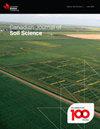在南阿尔伯塔黑钙土上对比24年的种植制度:作物产量、土壤碳和底土盐度
IF 1.5
4区 农林科学
Q4 SOIL SCIENCE
引用次数: 1
摘要
摘要具有多年生牧草和减少休耕频率的种植系统通常会增加土壤有机碳,从而提高土壤健康和作物产量。在阿尔伯塔省棕壤区24年轮作研究结束后,我们使用作物产量作为土壤健康的生物测定,评估了先前种植制度对半干旱地区后续产量和土壤特性的影响。在1992年至2015年的24个生长季节中,该研究包括三次休耕轮作、两次连续种植的年度轮作和多年生草干草,每次施用两到六次肥料。在2016年至2020年的生物测定期间,研究中的所有地块都被统一修剪。与未施肥的休耕小麦相比,经过24年的施肥,2015年秋季的土壤有机碳含量高出54%,在不休耕的轮作中,年产量高出14%。在生物测定年份,前一种种植制度对产量的最显著影响是2016年和2018年多年生草本植物产量较低。土壤电导率测量表明,多年生草本植物之后,底土盐度升高,这表明底土特性对健康土壤的重要性。由于休耕频率降低或作物多样性增加,作物生物测定第五年的作物产量增加了10%-20%。本研究中,种植制度对作物产量的长期影响取决于干旱强度,因为干旱强度抵消了土壤有机质和底土盐度的变化。本文章由计算机程序翻译,如有差异,请以英文原文为准。
Twenty-four years of contrasting cropping systems on a brown chernozem in Southern Alberta: crop yields, soil carbon, and subsoil salinity
Abstract Cropping systems with perennial forages and reduced fallow frequency generally increase soil organic carbon and thus subsequent soil health and crop yield. We evaluated the impact of prior cropping systems on subsequent yields and soil properties in a semiarid region by using crop yields as a bioassay of soil health following the termination of a 24-year crop rotation study in the Brown soil zone in Alberta. During 24 growing seasons from 1992 to 2015, the study included three fallow-containing rotations, two annual crop rotations that were cropped continuously, and perennial grass hay, each with two to six fertilizer treatments. During the bioassay period from 2016 through 2020, all plots in the study were uniformly cropped. Compared to unfertilized fallow wheat, soil organic C in the fall of 2015 was 54% higher after 24 years of fertilized grass and up to 14% higher following annual crops in rotations without fallow. The most notable impact of the previous cropping system on yield during the bioassay years was low yield following perennial grass in 2016 and 2018. Soil electrical conductivity measurements showed that subsoil salinity was elevated following perennial grass, demonstrating the importance of subsoil characteristics for healthy soils. Crop yields in the fifth year of the crop bioassay were 10%–20% greater due to reduced fallow frequency or increased crop diversity. The long-term impact of the cropping system on crop yield in this study depended on drought intensity due to counteracting changes in soil organic matter and subsoil salinity.
求助全文
通过发布文献求助,成功后即可免费获取论文全文。
去求助
来源期刊

Canadian Journal of Soil Science
农林科学-土壤科学
CiteScore
2.90
自引率
11.80%
发文量
73
审稿时长
6.0 months
期刊介绍:
The Canadian Journal of Soil Science is an international peer-reviewed journal published in cooperation with the Canadian Society of Soil Science. The journal publishes original research on the use, management, structure and development of soils and draws from the disciplines of soil science, agrometeorology, ecology, agricultural engineering, environmental science, hydrology, forestry, geology, geography and climatology. Research is published in a number of topic sections including: agrometeorology; ecology, biological processes and plant interactions; composition and chemical processes; physical processes and interfaces; genesis, landscape processes and relationships; contamination and environmental stewardship; and management for agricultural, forestry and urban uses.
 求助内容:
求助内容: 应助结果提醒方式:
应助结果提醒方式:


